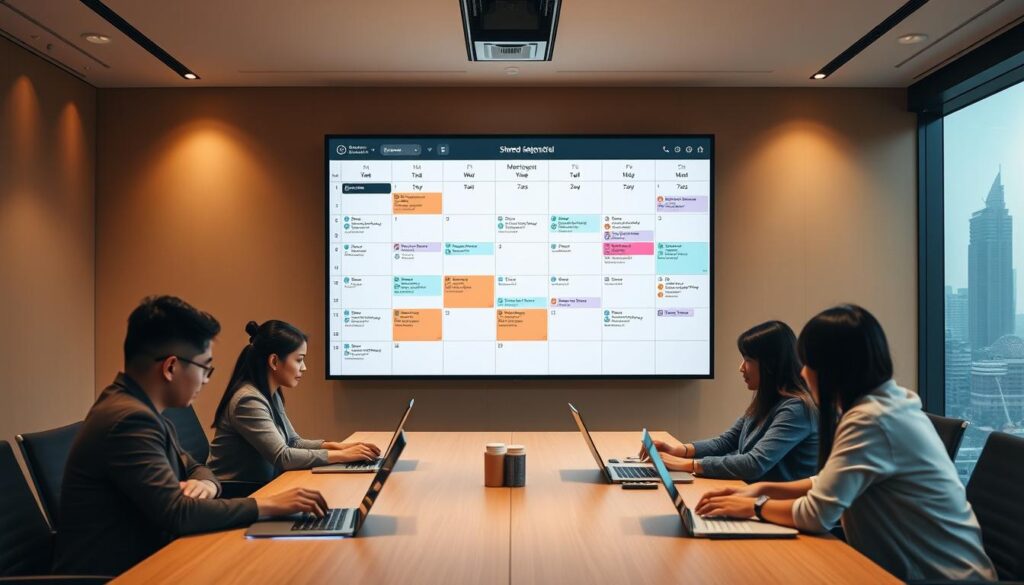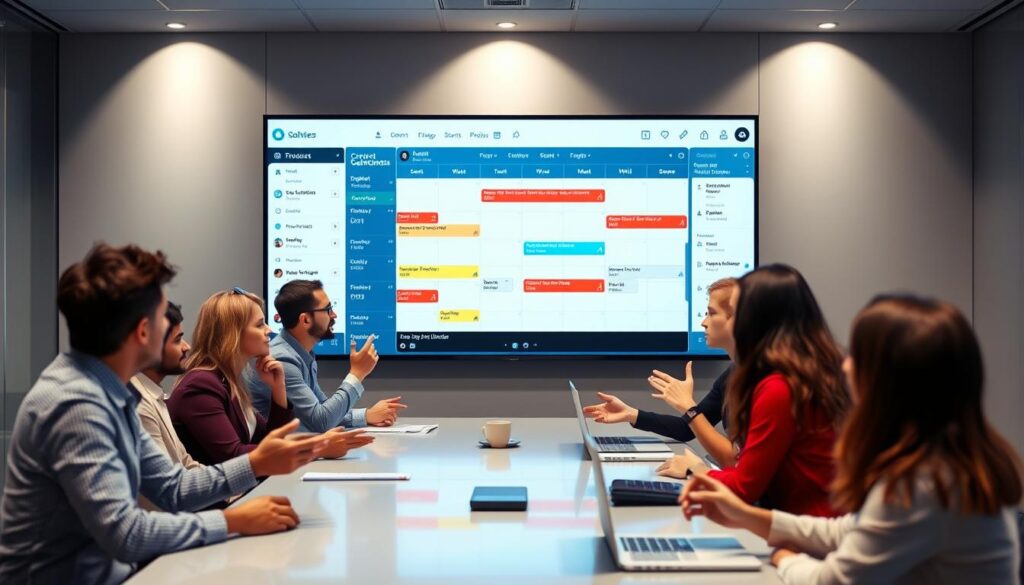Ever thought about how shared calendars can change project management in SMEs? Today, collaboration tools are key for better workflow, team talk, and meeting deadlines. In the Philippines, where teamwork is key, using shared calendars can really help manage projects well. This guide will show you how to set up shared calendars to improve your SME’s teamwork.
Key Takeaways
- Shared calendars enhance team communication and coordination.
- They streamline workflows and reduce project-related confusion.
- Choosing the right collaboration tools is crucial for SMEs.
- Proper setup can significantly increase project efficiency.
- Integration with existing project management tools is key.
Introduction to Shared Calendars in Project Management
Shared calendars are key in today’s fast-paced work world. They act as a central spot for team activities. This lets users schedule, view, and manage events easily.
They help by integrating deadlines, meetings, and tasks. This boosts productivity and teamwork.
Remote and hybrid work models have made shared calendars even more important. Teams can keep project timelines clear, making sure everyone is in sync. Many small and medium enterprises (SMEs) in the Philippines use these tools to improve communication and workflow.
For more on effective communication, check out this insightful resource.
Using shared calendars in project management tools helps teams overcome challenges. It also creates a collaborative atmosphere. As companies adjust to new work settings, these calendars are crucial for team alignment and project success.
The Evolution of Collaboration Tools
Collaboration tools have changed a lot, helping teams manage projects better. Looking at the history of calendars shows how we moved from old ways to new digital tools. Before, teams used physical calendars, which got messy as projects grew.
Then, digital calendars like Google Calendar and Microsoft Outlook came along. They made sharing schedules easier, improving teamwork. But, they still didn’t solve all the problems of managing projects.
Now, we have tools that do more than just schedule. They let us update things in real time, track tasks, and talk easily. This is key for working well in today’s fast world.

Understanding Shared Calendars
A shared calendar is a key tool for team collaboration. It’s different from personal calendars because many people can see and change it. It’s a central spot for planning projects, meeting deadlines, and tracking team activities.
Defining a Shared Calendar
A shared calendar is a digital space where many users can see and update the schedule together. It’s super helpful in project management. It keeps everyone on the same page with tasks and deadlines.
Key Features of Shared Calendars
- Real-time updates: Changes are seen by everyone right away, keeping the team informed.
- Multiple user access: Team members can add, change, or delete events easily without issues.
- Notifications and reminders: Alerts for deadlines or meetings keep the team on schedule.
- Integration with other tools: Shared calendars work well with project management software, making them even more useful.
Benefits of Using Shared Calendars
Shared calendars help teams work better together. They make it easy to plan and stay on track. Everyone can see who’s free and when, cutting down on confusion.
Enhancing Team Collaboration
Good teamwork is key to getting things done. Shared calendars help by keeping everyone in the loop. This means less time spent on who’s free and more on the work itself.
Streamlining Workflow and Reducing Confusion
Shared calendars make work flow smoother. Everyone sees the same schedule, so projects don’t get held up. Changes can be made quickly, saving time and boosting teamwork.

Companies using shared calendars see their projects done faster and better. These tools are crucial for managing projects, leading to better results and more efficiency.
| Aspect | Traditional Method | Using Shared Calendars |
|---|---|---|
| Team Awareness | Limited visibility | Full visibility into schedules |
| Communication | Frequent back-and-forth emails | Direct access to information |
| Task Management | Manual tracking of deadlines | Real-time updates on tasks |
| Accountability | Individual responsibility | Shared ownership of deadlines |
Integrating Shared Calendars with Project Management Tools
Using shared calendars with project management software boosts team work and talk. Tools like Monday.com, Asana, and ClickUp make it easy to manage tasks and keep up with calendar events. This way, teams get updates in real-time, making sure everyone knows about changes to project plans.
When calendars and collaboration tools work together, things run smoother. Teams see all project deadlines, milestones, and meetings in one place. This helps small and medium businesses in the Philippines manage big projects better. It keeps everyone on the same page and focused on what’s important.
Choosing the Right Collaboration Tools for Your Team
When picking the best collaboration tools for your team, think about what your projects need. A careful choice can boost productivity and make things run smoother. Look for tools that are easy to use, work well with what you already have, and can grow with your projects. The right calendar software is key to this.
Key Considerations When Selecting a Tool
- Usability: Make sure the tools are simple for everyone to use without needing a lot of training.
- Integration: Check if the tools can easily connect with other tools your team uses.
- Scalability: See if the tools can grow with your team or handle bigger projects later.
- Automation Features: Find tools with features that can do routine tasks for you, saving time and reducing mistakes.
Comparing Popular Calendar Tools
| Tool Name | Key Features | Best For |
|---|---|---|
| Google Calendar | Real-time sharing, integration with Gmail, reminders | General team collaboration |
| Microsoft Outlook Calendar | Integrated email, task management, meeting scheduling | Office environments |
| Calendly | Streamlined scheduling, availability sharing, integration | Meeting-heavy teams |
| Trello | Visual project management, checklist features, deadline tracking | Project-based teams |
Choosing wisely helps you find tools that fit your team’s goals and make task management better.

Best Practices for Setting Up Shared Calendars
Using shared calendars in your work can really help. Following the best practices makes them work better. It helps teams manage their time well and avoid confusion. Here are key tips for setting up shared calendars.
Defining Calendar Purpose and Categories
It’s important to know why you have a shared calendar. By categorizing events, team members can see their schedules better. For example, having different sections for deadlines, meetings, and personal time helps everyone know what’s important and when they’re free.
Maintaining Calendar Accuracy
Keeping the calendar up to date is key. Make sure everyone has the same information. Regular checks for conflicts and old entries help avoid mistakes and keep things running smoothly.
Encouraging Team Engagement
Getting your team involved makes them more likely to use the calendar. Ask for their input on categories and features. When team members help set up the calendar, they’re more likely to use it. This leads to better communication and teamwork.
Advanced Features in Shared Calendars
Modern shared calendars have cool features that make them more than just for scheduling. They can automate events and reminders, saving time. This means less manual work for everyone.
Custom views are another great feature. Teams can change their calendar to fit their needs. They can choose weekly, monthly, or agenda views, making it easier to work together.
They also work well with other tools for teamwork. For example, they can connect with project management software. This lets team members see deadlines and tasks in one place, without having to switch apps.

Some calendars even let teams work together in real-time. This means everyone can edit at the same time. It makes teamwork better and helps everyone work together more smoothly.
Real-World Examples of Shared Calendar Implementation in SMEs
Many SMEs in the Philippines have seen big improvements with shared calendars. A local consulting firm is a great example. They used shared calendars to better manage meeting times. This helped them talk better with clients and avoid scheduling conflicts.
A product development team also made great use of shared calendars. They paired them with tools like Asana. This made their work flow smoother and cut down on meetings. The team’s projects got done faster, and everyone worked better together.
| SME | Implemented Tool | Key Benefits |
|---|---|---|
| Local Consulting Firm | Shared Calendars | Enhanced client satisfaction, improved communication |
| Product Development Team | Shared Calendars with Asana | Streamlined workflows, reduced status meetings |
Conclusion
Shared calendars are key in today’s project management. They help teams, mainly small and medium enterprises (SMEs) in the Philippines. They make work flow better and improve teamwork, making everyone more productive.
Using shared calendars helps keep everyone on the same page. It makes sure everyone knows their tasks and deadlines. This leads to better communication and keeps everyone updated in real time.
As businesses move online, using shared calendars is crucial. It boosts productivity and success. SMEs will see how these tools make managing projects easier and better.
By using shared calendars, teams work better together. Projects get done on time and meet everyone’s expectations. It’s a win-win for both clients and team members.
FAQ
What are shared calendars in project management?
Shared calendars are digital tools that let many users see and manage events together. They act as a central spot for organizing work and keeping everyone on the same page.
How do shared calendars improve team collaboration?
Shared calendars make it easier to see everyone’s schedule. This clear view helps teams work together smoothly and cuts down on unnecessary talks.
Are shared calendars essential for SMEs?
Yes, they are very important for small and medium businesses. They help manage many projects and tasks, making it clear who does what and when.
Which collaboration tools can integrate with shared calendars?
Tools like Monday.com, Asana, and ClickUp can connect with shared calendars. This lets teams update each other in real time, making work flow better.
What should I consider when choosing collaboration tools?
Look at how easy they are to use, if they work with your current tools, if they grow with your team, and if they automate tasks. Choose one that fits your team’s needs well.
How can I implement best practices for shared calendars?
First, decide what the calendar will be for and how it will be set up. Then, get your team to use it often to keep it accurate and useful.
What advanced features are available in modern shared calendars?
Today’s shared calendars have cool features like automation, custom views, and integrations. These help make work easier and more efficient.
Can you provide examples of SMEs using shared calendars successfully?
Sure! A consulting firm in the Philippines used shared calendars to better manage meetings. This helped avoid scheduling conflicts and kept everyone informed.